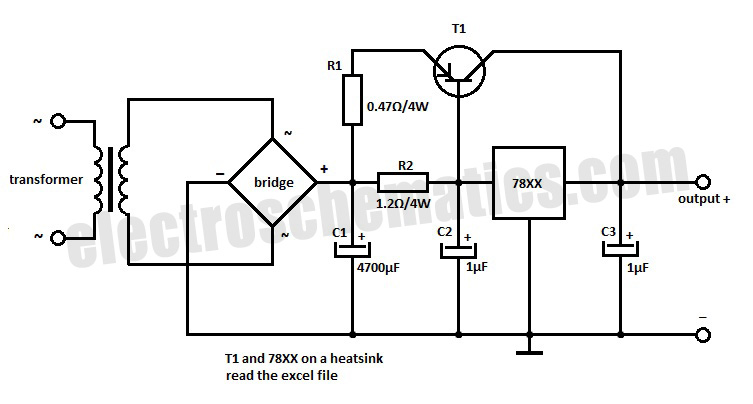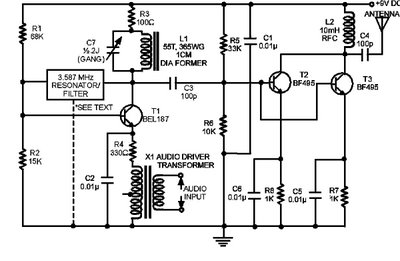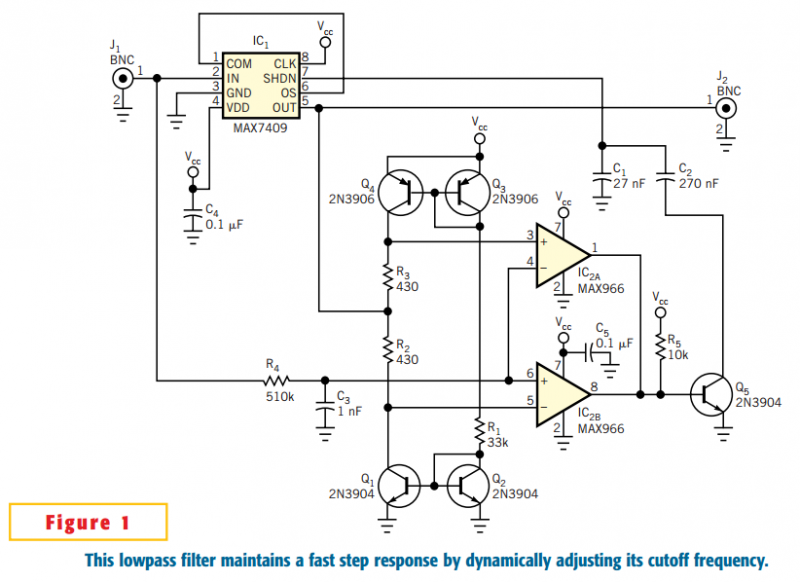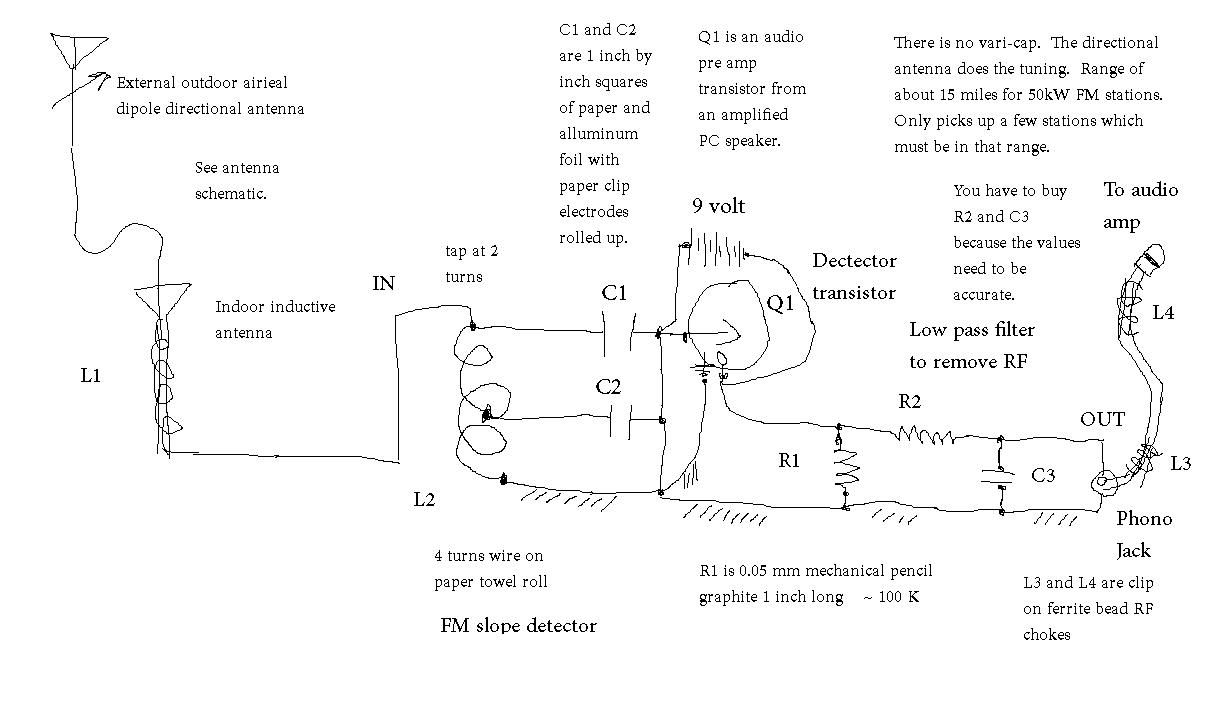
LM317T Voltage Regulator with Pass Transistor
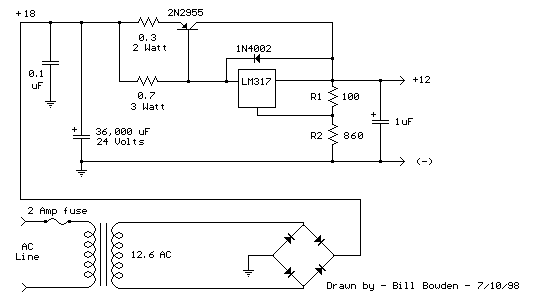
The output current of the LM317T can be increased by incorporating an additional power transistor to share part of the total current. The current sharing is determined by a resistor connected in series with the input of the LM317 and another resistor in series with the emitter of the pass transistor. The pass transistor begins conducting when the LM317 current reaches approximately 1 amp, due to the voltage drop across the 0.7-ohm resistor. Current limiting occurs at around 2 amps for the LM317, which results in a voltage drop of about 1.4 volts across the 0.7-ohm resistor and a 700-millivolt drop across the 0.3-ohm emitter resistor. Consequently, the total current is limited to approximately 2 + (0.7 / 0.3) = 4.3 amps. The input voltage must be around 5.5 volts higher than the output at full load, and the heat dissipation at full load would be approximately 23 watts, necessitating a substantial heat sink for both the regulator and the pass transistor. The filter capacitor size can be estimated using the formula C = IT/E, where I represents the current, T is the half-cycle time (8.33 ms at 60 Hertz), and E is the voltage drop that occurs during one half-cycle. To maintain the ripple voltage below 1 volt at 4.3 amps, a filter capacitor of at least 36,000 µF is required. The power transformer should be sufficiently sized to ensure that the peak input voltage to the regulator remains 5.5 volts above the output at full load, which equates to 17.5 volts for a 12-volt output. This accommodates a 3-volt drop across the regulator, a 1.5-volt drop across the series resistor (0.7 ohm), and 1 volt of ripple produced by the filter capacitor. A larger filter capacitor will reduce the input requirements, albeit to a limited extent.
To design a circuit utilizing the LM317T for increased output current, it is essential to integrate a power transistor, typically an NPN type, which will serve as the pass transistor. The configuration involves connecting the collector of the NPN transistor to the output of the LM317T and the emitter to the load. The resistor in series with the LM317T input should be chosen to limit the current and ensure the safe operation of the LM317T, while the emitter resistor should be calibrated to facilitate proper current sharing between the LM317T and the power transistor.
The heat dissipation characteristics of the circuit necessitate careful thermal management. The LM317T and the pass transistor should be mounted on heat sinks capable of dissipating at least 23 watts to prevent thermal overload. The selection of the heat sink will depend on the ambient temperature and the thermal resistance of the heat sink material.
For the filter capacitor, the selection of a 36,000 µF capacitor is crucial for maintaining stable output voltage and minimizing ripple at full load. The capacitor must be rated for a voltage higher than the peak input voltage to ensure reliability. The power transformer should be rated to handle the required output current, with a secondary voltage that provides adequate headroom above the output voltage to account for the voltage drops across the regulator and series resistors.
The circuit design should also include appropriate protection features, such as fuses or circuit breakers, to safeguard against overcurrent conditions. Additionally, bypass capacitors may be included at the input and output of the LM317T to filter high-frequency noise and improve transient response. The overall design must adhere to best practices in PCB layout to minimize inductance and resistance in the power paths, ensuring stable operation under varying load conditions.The LM317T output current can be increased by using an additional power transistor to share a portion of the total current. The amount of current sharing is established with a resistor placed in series with the 317 input and a resistor placed in series with the emitter of the pass transistor.
In the figure below, the pass transistor will start con ducting when the LM317 current reaches about 1 amp, due to the voltage drop across the 0. 7 ohm resistor. Current limiting occurs at about 2 amps for the LM317 which will drop about 1. 4 volts across the 0. 7 ohm resistor and produce a 700 millivolt drop across the 0. 3 ohm emitter resistor. Thus the total current is limited to about 2+ (. 7/. 3) = 4. 3 amps. The input voltage will need to be about 5. 5 volts greater than the output at full load and heat dissipation at full load would be about 23 watts, so a fairly large heat sink may be needed for both the regulator and pass transistor. The filter capacitor size can be approximated from C=IT/E where I is the current, T is the half cycle time (8.
33 mS at 60 Hertz), and E is the fall in voltage that will occur during one half cycle. To keep the ripple voltage below 1 volt at 4. 3 amps, a 36, 000 uF or greater filter capacitor is needed. The power transformer should be large enough so that the peak input voltage to the regulator remains 5. 5 volts above the output at full load, or 17. 5 volts for a 12 volt output. This allows for a 3 volt drop across the regulator, plus a 1. 5 volt drop across the series resistor (0. 7 ohm), and 1 volt of ripple produced by the filter capacitor. A larger filter capacitor will reduce the input requirements, but not much. 🔗 External reference
To design a circuit utilizing the LM317T for increased output current, it is essential to integrate a power transistor, typically an NPN type, which will serve as the pass transistor. The configuration involves connecting the collector of the NPN transistor to the output of the LM317T and the emitter to the load. The resistor in series with the LM317T input should be chosen to limit the current and ensure the safe operation of the LM317T, while the emitter resistor should be calibrated to facilitate proper current sharing between the LM317T and the power transistor.
The heat dissipation characteristics of the circuit necessitate careful thermal management. The LM317T and the pass transistor should be mounted on heat sinks capable of dissipating at least 23 watts to prevent thermal overload. The selection of the heat sink will depend on the ambient temperature and the thermal resistance of the heat sink material.
For the filter capacitor, the selection of a 36,000 µF capacitor is crucial for maintaining stable output voltage and minimizing ripple at full load. The capacitor must be rated for a voltage higher than the peak input voltage to ensure reliability. The power transformer should be rated to handle the required output current, with a secondary voltage that provides adequate headroom above the output voltage to account for the voltage drops across the regulator and series resistors.
The circuit design should also include appropriate protection features, such as fuses or circuit breakers, to safeguard against overcurrent conditions. Additionally, bypass capacitors may be included at the input and output of the LM317T to filter high-frequency noise and improve transient response. The overall design must adhere to best practices in PCB layout to minimize inductance and resistance in the power paths, ensuring stable operation under varying load conditions.The LM317T output current can be increased by using an additional power transistor to share a portion of the total current. The amount of current sharing is established with a resistor placed in series with the 317 input and a resistor placed in series with the emitter of the pass transistor.
In the figure below, the pass transistor will start con ducting when the LM317 current reaches about 1 amp, due to the voltage drop across the 0. 7 ohm resistor. Current limiting occurs at about 2 amps for the LM317 which will drop about 1. 4 volts across the 0. 7 ohm resistor and produce a 700 millivolt drop across the 0. 3 ohm emitter resistor. Thus the total current is limited to about 2+ (. 7/. 3) = 4. 3 amps. The input voltage will need to be about 5. 5 volts greater than the output at full load and heat dissipation at full load would be about 23 watts, so a fairly large heat sink may be needed for both the regulator and pass transistor. The filter capacitor size can be approximated from C=IT/E where I is the current, T is the half cycle time (8.
33 mS at 60 Hertz), and E is the fall in voltage that will occur during one half cycle. To keep the ripple voltage below 1 volt at 4. 3 amps, a 36, 000 uF or greater filter capacitor is needed. The power transformer should be large enough so that the peak input voltage to the regulator remains 5. 5 volts above the output at full load, or 17. 5 volts for a 12 volt output. This allows for a 3 volt drop across the regulator, plus a 1. 5 volt drop across the series resistor (0. 7 ohm), and 1 volt of ripple produced by the filter capacitor. A larger filter capacitor will reduce the input requirements, but not much. 🔗 External reference


